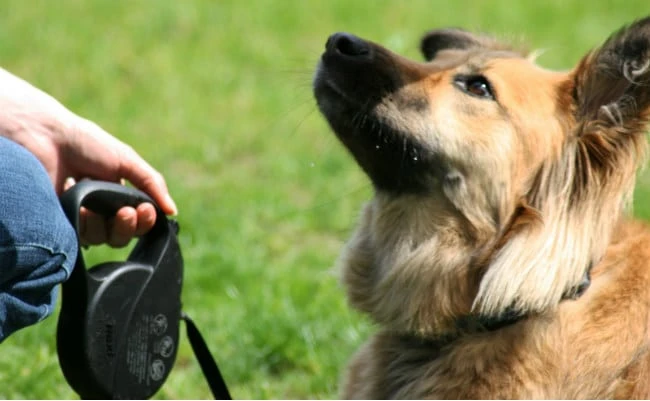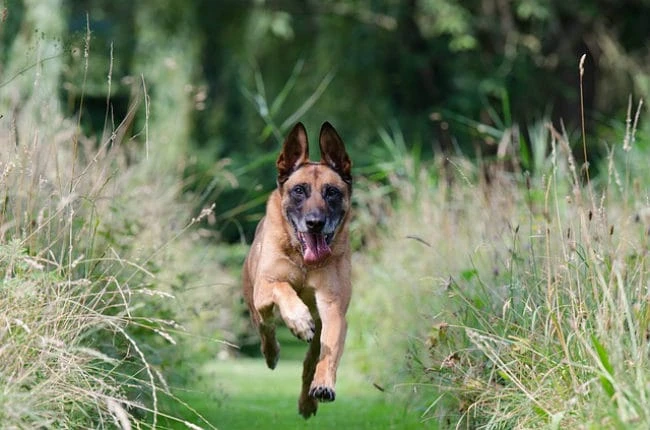Training Your Dog To Make Eye Contact & Focus

It is extremely useful to teach your dog the ‘focus’ command. When the focus command is given, the dog should make eye contact with the speaker and await the next instruction. Having your dog focus on you before giving further commands makes it easier for the dog to listen and obey, as it puts the dog in an “awaiting next instruction” state of mind. Teaching your dog to focus is very easy, here’s how it’s done.
Training Your Dog To Make Eye Contact – Phase One
1. Choose a word for your focus command. Any word will work, but ideally you should choose a word that the dog will not hear casually. The less often your dog hears “focus” out of context, the stronger the association of the word with the action.
2. Have your dog sit in front of you. Ideally you should be sitting so that you are close to eye-level with your dog.
3. Hold a treat your dog enjoys in a closed hand. Let your dog know that you are holding the treat.
4. Once your dog is interested in the treat, probably trying to sniff it out of your hand, quickly whip your hand behind your own head. As you move the treat, say “focus.” Your dog is likely to keep staring at the treat as it moves, making eye contact with you as the treat passes behind your head.
5. If your dog does make eye contact, even very briefly, say “good focus” and hand over the treat.
6. If your dog fails to make eye contact, do not treat or say “good focus.” Instead, return to step 3 and try again.
After many repetitions of the above, your dog will begin to understand the association between the word you speak, the way you move your hand, the eye contact, and the resulting treat. Once your dog has made these mental connections, phase one of “focus” training has been a success. Phase two is all about removing context, so that the command will work when you’re not sitting on the floor holding a treat behind your head!
Training Your Dog To Make Eye Contact – Phase Two
Phase two can sometimes be quite a non-event. Depending on the dog, it may be as simple as saying “focus” outside the training context and being delighted when it immediately works.
If you are less lucky, you will need to take steps to remove the context of the “focus” command, stripping it down to simply a word and an action rather than a word, an action, a place, a tone of voice, a treat, a person, and so on.
Teaching your dog to “focus” in any context is easy if you understand a little bit about the way dogs learn. Dogs learn by realizing when one thing is linked to another thing, for example:
- The rustle of a dog food container is associated with getting food.
- Night falling is associated with the household going to bed.
- Chewing on shoes is associated with being scolded.
Unfortunately, dogs often pay more attention to context than their trainers might like.
If all of your training sessions for “focus” take place in the living room, you may find that your dog will perform the command perfectly in the living room and completely ignore it when you are elsewhere. Similarly, a dog may learn not to dig up one section of the garden only to move on and dig up a different area. It isn’t that the dog is behaving badly on purpose; they just have trouble understanding that a rule in situation A also applies in situation B.
Stripping your “focus” command down to nothing but a word is easy:
Begin by going through the usual steps from phase one a couple of times, giving your dog the treat and saying “good focus” upon success. After a couple of successful “focus” responses, start making deliberate alterations to your behavior. For example:
- Don’t move the treat in your hand all the way behind your head.
- Try the command while standing rather than sitting.
- Say “focus” in various different tones of voice.
- Conduct training sessions in different physical locations.
- Don’t always give your dog the treat, but always say “good focus” upon success.
- Spring the training on your dog at random, rather than having a formal session.
- Have other people go through these steps.
- Mix in other commands, like having your dog lie down and then focus, as this encourages the dog to listen to the specific words you’re using.
Essentially, the idea is to make every part of the situation unpredictable except for the “focus” word, the action the dog must perform, and your approval.
With repetition, your dog will easily learn both the fundamental idea of “focus” and to obey it in any context. Lastly, an important note for anyone teaching their dog to focus:
Dogs are born with an instinctual idea about the significance of eye contact, which you need to understand and manage.
Dogs consider eye contact to be an assertive or even aggressive gesture. A lowly member of a pack would not dare make prolonged eye contact with the alpha, because that would be a challenge. A beta in a pack might have a staring contest with the alpha, but that would be the beginnings of a dominance struggle.
The human-dog relationship is not the same as dog-dog relationship, and eye contact does not always constitute a challenge. Just be aware that you can make your dog very uncomfortable if you force prolonged eye contact.



